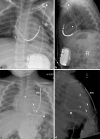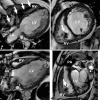Implantable cardioverter-defibrillators in congenital heart disease
- PMID: 27250725
- PMCID: PMC4894938
- DOI: 10.1007/s00399-016-0437-3
Implantable cardioverter-defibrillators in congenital heart disease
Abstract
Implantable cardioverter-defibrillators (ICD) have an important role in reducing sudden cardiac death in patients with congenital heart disease (CHD); however, the benefit of ICDs needs to be weighed up against both short-term and long-term adverse effects, which are difficult to evaluate in the heterogeneous CHD population. A tailored approach, taking into account risk stratification and patient-specific factors, is needed to select the most appropriate strategy. This review discusses primary and secondary ICD indications, implantation approaches and long-term follow-up. Recent publications have shed light on the concerns of system longevity, lead extractions, inappropriate shocks and impact on the quality of life. All of these factors require consideration prior to commitment to this long-term treatment strategy.
Implantierbare Kardioverter-Defibrillatoren (ICD) spielen bei Patienten mit angeborenen Herzfehlern (AHF) eine entscheidende Rolle bezüglich der Reduktion des plötzlichen Herztods. Die Vorteile einer ICD-Implantation müssen jedoch den potenziellen akuten, aber auch langfristigen Komplikationen gegenübergestellt werden, was insbesondere bei der Gruppe der AHF-Patienten schwierig ist. Individuelle Strategien, die den patienten-spezifischen Faktoren einerseits und der notwendigen Risikostratifizierung andererseits Rechnung tragen, müssen sorgfältig erarbeitet werden. In diesem Übersichtsartikel werden die ICD-Indikationen zur Primär- und Sekundärprophylaxe, die Implantationstechniken und die Ergebnisse aus der langfristigen Nachbeobachtung diskutiert. Daten aus aktuellen Studien belegen spezifische Limitationen bezüglich Haltbarkeit der Systeme, Umsetzbarkeit von Sondenextraktionen, inadäquaten Schockabgaben und Reduktion der Lebensqualität. Alle diese Faktoren müssen sorgsam abgewogen werden, bevor bei Patienten mit angeborenen Herzfehlern über eine ICD-Implantation als langfristige Behandlungsstrategie entschieden wird.
Keywords: Congenital heart disease; Implantable cardioverter-defibrillator; Sudden cardiac death; Ventricular tachycardia.
Figures






Similar articles
-
Long-term follow-up of implantable cardioverter-defibrillators in adult congenital heart disease patients: indications and outcomes.Europace. 2017 Mar 1;19(3):407-413. doi: 10.1093/europace/euw076. Europace. 2017. PMID: 27234868
-
Single-center experience with implantable cardioverter-defibrillators in adults with complex congenital heart disease.Am J Cardiol. 2011 Sep 1;108(5):729-34. doi: 10.1016/j.amjcard.2011.04.020. Epub 2011 Jun 22. Am J Cardiol. 2011. PMID: 21684513
-
Long-term follow-up of adult patients with congenital heart disease and an implantable cardioverter defibrillator.Congenit Heart Dis. 2019 Jul;14(4):525-533. doi: 10.1111/chd.12767. Epub 2019 Mar 19. Congenit Heart Dis. 2019. PMID: 30889316
-
Ventricular arrhythmias and sudden cardiac death in adults with congenital heart disease.Heart. 2016 Nov 1;102(21):1703-1709. doi: 10.1136/heartjnl-2015-309069. Epub 2016 Jun 1. Heart. 2016. PMID: 27250216 Review.
-
[The subcutaneous cardioverter-defibrillator: When less is more].Herzschrittmacherther Elektrophysiol. 2015 Jun;26(2):123-8. doi: 10.1007/s00399-015-0378-2. Epub 2015 Jun 10. Herzschrittmacherther Elektrophysiol. 2015. PMID: 26058997 Review. German.
Cited by
-
Review of rhythm disturbances in patient after fontan completion: epidemiology, management, and surveillance.Front Pediatr. 2025 Feb 12;13:1506690. doi: 10.3389/fped.2025.1506690. eCollection 2025. Front Pediatr. 2025. PMID: 40013112 Free PMC article. Review.
-
Implantable cardioverter defibrillator therapy in grown-up patients with transposition of the great arteries-role of anti-tachycardia pacing.J Thorac Dis. 2018 Jun;10(Suppl 15):S1769-S1776. doi: 10.21037/jtd.2018.01.159. J Thorac Dis. 2018. PMID: 30034851 Free PMC article.
-
Epicardial cardioverter defibrillator implantation due to post-fontan ventricular tachycardia.Ann Card Anaesth. 2020 Apr-Jun;23(2):235-236. doi: 10.4103/aca.ACA_234_18. Ann Card Anaesth. 2020. PMID: 32275046 Free PMC article.
-
Use of magnetic resonance imaging combined with gene analysis for the diagnosis of fetal congenital heart disease.BMC Med Imaging. 2019 Jan 25;19(1):12. doi: 10.1186/s12880-019-0314-8. BMC Med Imaging. 2019. PMID: 30683072 Free PMC article.
References
-
- Atallah J, Erickson CC, Cecchin F, et al. Multi-institutional study of implantable defibrillator lead performance in children and young adults: results of the Pediatric Lead Extractability and Survival Evaluation (PLEASE) study. Circulation. 2013;127:2393–2402. doi: 10.1161/CIRCULATIONAHA.112.001120. - DOI - PubMed
Publication types
MeSH terms
LinkOut - more resources
Full Text Sources
Other Literature Sources
Medical

